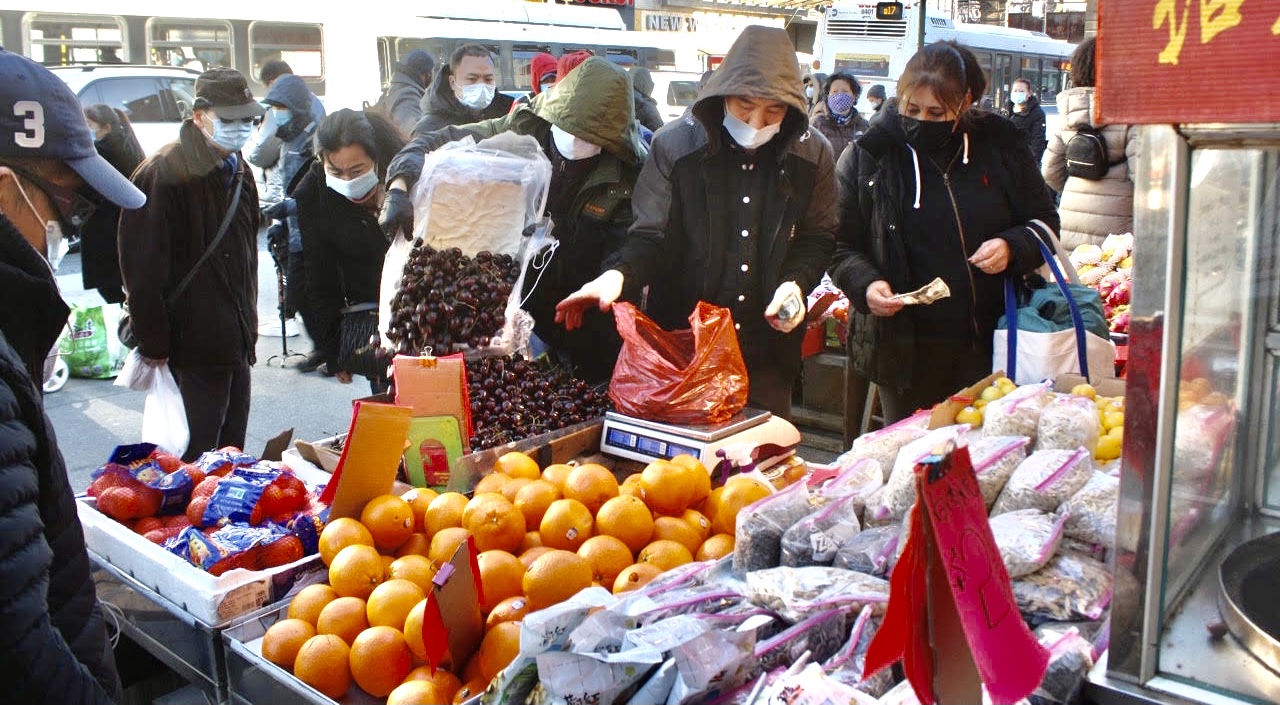
FLUSHING — A fruit vendor on Roosevelt Avenue unloaded a cascade of plump Bing cherries near a mound of fresh softball-size oranges — an action that without words drew an audience.
On a Monday in early March, Roosevelt Avenue bustled with pedestrians, mostly Asian, and a few Latinos and African Americans.
Aside from face masks worn by everyone, there was no immediate sign that the COVID-19 Pandemic over the past year dealt a mean gut-punch to the local economy of downtown Flushing.
But a first glance misses the bigger story. Turn off of Roosevelt and keep going, said DianSong Yu, executive director of the Flushing Business Improvement District.
“When you walk the side streets, you see the impact of the pandemic,” Yu said. “You see the closures, businesses down, lack of pedestrians — then you really start to see the impact.”
Foot traffic was noticeably less on a stroll up 41st Avenue toward St. Michael’s Parish. But at the rectory, Msgr. John Vesey, the pastor, added his own assessment.
“We estimated between 80 and 90 percent of our people, in our parish, lost their jobs,” he said. “They are all-day laborers or restaurant workers. We don’t have people doing these high-tech jobs. This was just devastating.”
It got worse.
“In our parish, we calculate between 200 and 240 people have died from coronavirus,” Msgr. Vesey said. “And the most painful thing for us is you couldn’t go and be with them.”
Msgr. Vesey said about 2,500 people belong to the parish.
Pandemic’s economic hit
Downtown Flushing’s economic base is a mix of hair and nail salons, retail, hospitals, hotels, pharmacies, banks, and about 230 restaurants, Yu said.
The neighborhood is known as a go-to destination for all sorts of Asian cuisine, from seafood and crab to barbecue, noodles, and dumplings, to name just a few.
“Authentic,” Yu described the cavalcade of restaurants. “I recommend all of it.”
But profits from inside dining vanished in the early days of the pandemic when lockdowns closed everything except “essential” businesses. Restaurants relied on takeout deliveries, but revenue sagged. Owners cut overhead by laying off workers.
Yu explained most of these restaurants are family-owned, so relatives filled in for the let-go waitstaff and food-prep workers. Still, many restaurants couldn’t endure the downturn.
“What we experienced this past year is like 25-35 restaurants had a turnover or closed,” he added.
But the neighborhood’s estimated 100 beauty salons took a bigger hit, Yu said. Nearly half, he added, went out of business.
“For nail salons and facials in the age of the pandemic — I don’t think a lot of customers wanted to go that route because the workers have to stand so close to you,” Yu said. “It’s a tough business to be in because it is very competitive. When the economy is fine, everyone is able to survive.
“But when it goes south, there is nothing to support those businesses.”
Not every sector suffered, Yu said. Banks are doing fine, he noted, and the grocery industry thrived.
“With people doing less dining out, they were cooking at home more,” Yu explained. “As a matter of fact, we have a new grocery market going up on Main Street in the old Modell’s [sporting goods]. It’s a good sign.”
Msgr. Vesey said he is not surprised to hear that relatives stepped in to keep family-owned restaurants going. Meanwhile, out-of-work parishioners sought labor elsewhere.

He recalled how some people found restaurant work in Connecticut and commute each day in crowded vans.
The restaurant industry began clawing back to life in the fall when restrictions eased to allow curbside dining. Now, restaurants can offer inside sit-down service, but only at 35 percent capacity.
That’s good, but the industry needs more, said Veronica Tsang, a flushing businesswoman in finance who belongs to St. Michael’s Parish.
“If you walk along Main Street, you see things are a little better,” she said. “But think about this: most restaurants are small. So let’s say they’re allowed to open at 25 percent. Which is what, two tables? How are they going to survive?”
Yu said businesses could apply for federal small business loans or grants, but nothing beats a sustained return of enthusiastic clientele.
“Loans are a short-term thing,” Yu said. “It’s crucial these businesses get their customers back — these consumers, the diners, and the shoppers. Otherwise, I just don’t see it.”
More steps needed
Tsang suggested a boost in police security to help shoppers and diners feel safe on the streets. She commented in the wake of a nationwide upsurge of attacks on Asian Americans, many of them elderly.
A recent study showed that hate crimes, in general, were lower across the U.S. in 2020, but such attacks on Asian Americans intensified since the start of the pandemic.
The Center for the Study of Hate & Extremism at California State University, San Bernardino, conducted the study. It tracked 1,845 nationwide hate crimes in 2019, but the total dropped to 1,717 in 2020.
Meanwhile, however, crimes against Asian people grew from 49 in 2019 to 122 a year later. New York City, the study showed, saw three anti-Asian crimes in 2019, and 28 in 2020.
Flushing residents saw the violence continue in 2021. The afore-mentioned fruit vendor is next to the bakery where a man on Feb. 16 shoved a middle-aged Chinese woman. She crashed into a row of newsstands and needed 10 stitches to close a cut to her head.
The incident got extensive news coverage, and actress Olivia Munn led a viral campaign of outrage on social media. Police got a flurry of tips and arrested a suspect two days later.
“People are afraid to go out, even in broad daylight,” Tsang said. “Even getting on the 7 train, people are afraid. They’re not worried about a mugging; it is being targeted because of your race.
“The Police Department has to step up.”
Police have said it sometimes can be hard to distinguish between a random aggravated robbery or an actual “hate crime” in which the angry attacker blames the pandemic on an Asian person. They also expressed concern that anti-Asian attacks may go unreported.
To that end, the New York Police Department formed the Asian Hate Crime Task Force.
Lt. Stephen Luo recently made an appeal on social media in Chinese with English subtitles.
“Please come forward and report any hate crimes,” he said. “Without you reporting the crime, we are unable to extend any of our help. Lastly, we do not ask questions about your immigration status, nor does it matter in the course of our investigation.”
Lt. Luo said to report crime by email to AsianHCTF@nypd.org, “or you can report the crime to your local police station.”
The vaccine
When asked his opinion about jumpstarting the economy, Msgr. Vesey did not hesitate.
“Vaccine,” he said flatly. “I think so much fear was put into the minds and hearts of the people from the beginning. And that has stayed with people. On Main Street, you see people all over the place, but people are still afraid to come to church. And that is across the board — also our Latino community and English-speaking community, especially the older folk.”
Some have not been out in a year, Msgr. Vesey said.
“So I think the only way to help a lot of our people is with vaccines,” he said. “It’s really important people be given the opportunity to see that there is hope.”
